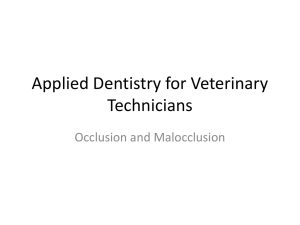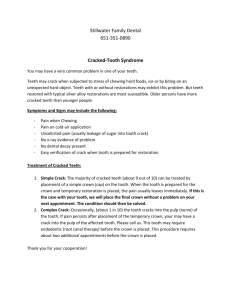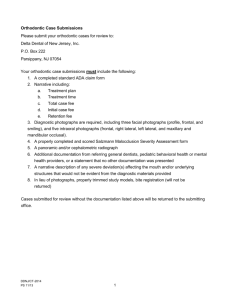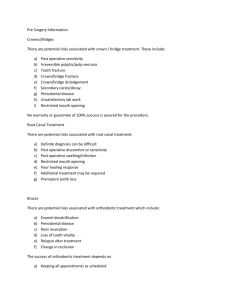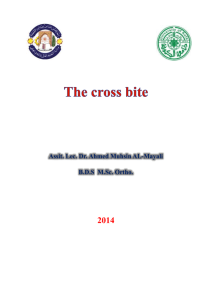Aims of orthodontics
advertisement
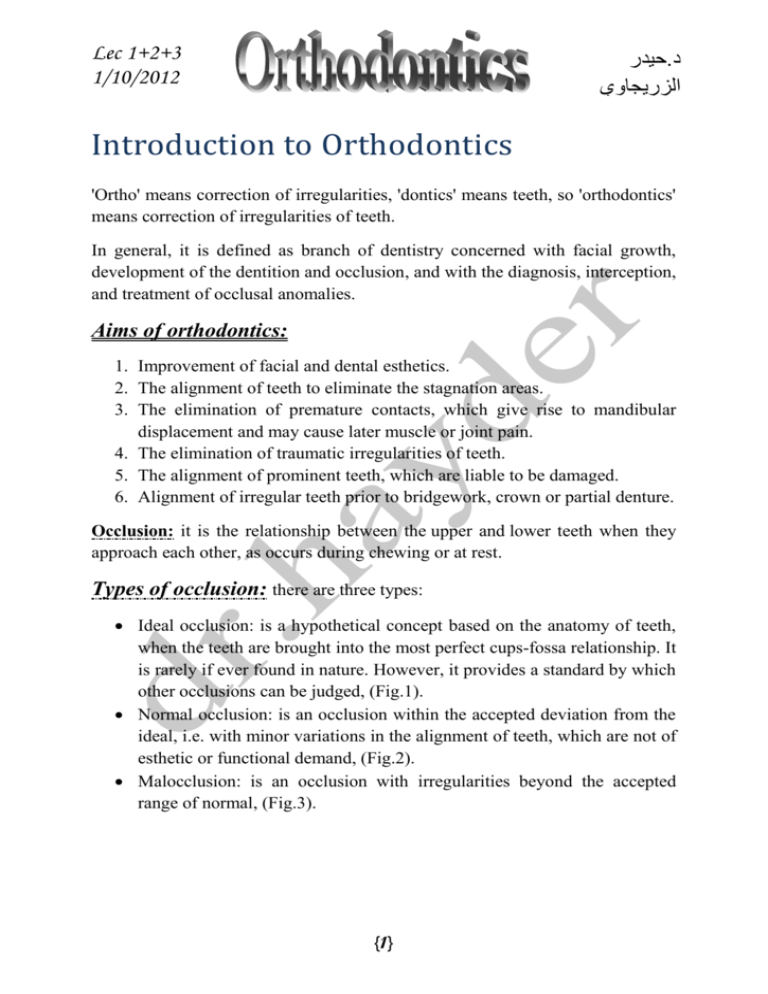
Lec 1+2+3
1/10/2012
حيدر.د
الزريجاوي
Introduction to Orthodontics
'Ortho' means correction of irregularities, 'dontics' means teeth, so 'orthodontics'
means correction of irregularities of teeth.
In general, it is defined as branch of dentistry concerned with facial growth,
development of the dentition and occlusion, and with the diagnosis, interception,
and treatment of occlusal anomalies.
Aims of orthodontics:
1. Improvement of facial and dental esthetics.
2. The alignment of teeth to eliminate the stagnation areas.
3. The elimination of premature contacts, which give rise to mandibular
displacement and may cause later muscle or joint pain.
4. The elimination of traumatic irregularities of teeth.
5. The alignment of prominent teeth, which are liable to be damaged.
6. Alignment of irregular teeth prior to bridgework, crown or partial denture.
Occlusion: it is the relationship between the upper and lower teeth when they
approach each other, as occurs during chewing or at rest.
Types of occlusion: there are three types:
Ideal occlusion: is a hypothetical concept based on the anatomy of teeth,
when the teeth are brought into the most perfect cups-fossa relationship. It
is rarely if ever found in nature. However, it provides a standard by which
other occlusions can be judged, (Fig.1).
Normal occlusion: is an occlusion within the accepted deviation from the
ideal, i.e. with minor variations in the alignment of teeth, which are not of
esthetic or functional demand, (Fig.2).
Malocclusion: is an occlusion with irregularities beyond the accepted
range of normal, (Fig.3).
{1}
Lec 1+2+3….…………………………………………… Introduction to orthodontics
Fig.2: Normal Occlusion
Fig.1: Ideal occlusion
Fig. 3: Malocclusion
Orthodontic terms:
Overjet: is the horizontal distance between the upper and
lower incisors in occlusion, measured at the tip of the
incisors. It is of four types:
A.
B.
C.
D.
Normal: if it's value (2-4) mm.
Edge to edge: equal 0.
Reverse Overjet: less than 0.
Excessive Overjet: more than 4mm.
{2}
Lec 1+2+3….…………………………………………… Introduction to orthodontics
Types of Overjet
Overbite: is the vertical distance between the tips of the upper and lower
incisors in occlusion. It is of four types:
A.
B.
C.
D.
Normal: if it’s value (2-4) mm.
Deep: more than 4mm.
Edge to edge: equal 0.
Open bite: less than 0.
Types of overbite
Crossbite: is a discrepancy in the buccolingual relationship of the upper and
lower teeth. Crossbite can involve a single tooth or a group of teeth. It can be
classified as anterior or posterior and bilateral or unilateral. Also it may be false
or true i.e. with or without mandibular displacement.
{3}
Lec 1+2+3….…………………………………………… Introduction to orthodontics
Anterior crossbite: involving one or more incisors or canines, it may be
associated with anterior mandibular displacement.
Posterior crossbite: involving one or more molars or premolars, it is of two
types:
Buccal Crossbite: in which the buccal cusp of a lower tooth lies buccal to
the maximum height of a buccal cusp of an opposing upper tooth.
Lingual Crossbite (Scissor bite): in which the buccal cusp of a lower tooth
lies lingual to the maximum height of a lingual cusp of an opposing upper
tooth.
Posterior crossbite may affect both sides of the dental arch so it called bilateral
crossbite or affect one side and named unilateral crossbite.
Unilateral posterior crossbite could be either:
False which associated with lateral mandibular displacement either to right or
left and usually noticed by a midline shift.
True in which there is no lateral mandibular displacement, usually seen in
adults.
Mandibular displacement: is the deflection of the mandible on closing due to
presence of an occlusal interference that requires the mandible to shift either
anteriorly and/or laterally in order to achieve a comfortable maximum occlusion.
{4}
Lec 1+2+3….…………………………………………… Introduction to orthodontics
Space discrepancy: is the difference between the spaces needed and space
available in the dental arch.
Space discrepancy = space available – space needed.
Space discrepancy could be cause either crowding or spacing, which range from
mild, moderate to severe.
It may be localized (in anterior or in posterior region only) or generalized (affect
the entire dental arch).
"Crowding" is the lack of sufficient space for all the teeth in the dental arch, it
associated with rotation and displacement of teeth.
"Spacing" is the presence of extra space in the dental arch associated with spaces
between the teeth.
Crowding
Spacing
Midline shift: is lack of coincidence
between the upper and lower dental midline
with each other and/or with the facial
midline.
Dental midline shift
{5}
Lec 1+2+3….…………………………………………… Introduction to orthodontics
Classification of malocclusion:
Angle classification:
Angle had described three classes of malocclusion, based on the occlusal
relationships of the upper & lower first molars:
Class I malocclusion: the mesiobuccal cusp of the upper 1st molar occludes in
the buccal groove of the lower 1st molar, but line of occlusion incorrect because
of malposed teeth, rotations, or other causes.
Class II malocclusion: Lower 1st molar distally positioned relative to upper 1 st
molar, line of occlusion not specified.
Class III malocclusion: Lower 1st molar mesially positioned relative to upper 1st
molar, line of occlusion not specified.
Class I
Class II
Class III
British classification:
This is based on the incisor relationship :
Class I: the lower incisor edges occlude with or lie immediately below the
cingulum plateau of the upper central incisors.
Class II: the lower edges lie posterior to the cingulum plateau of the upper
incisors. There are two subdivision of this categories:
{6}
Lec 1+2+3….…………………………………………… Introduction to orthodontics
Division 1: the upper incisors are proclined or of average inclination and
there is an increase in Overjet.
Division 2: the upper central incisors are retroclined and the Overjet is
usually minimal or may be increased.
Class III: the lower incisor edges lie anterior to the cingulum plateau of the
upper incisors. The Overjet is reduced or reversed.
Incisor Classification
Types of tooth movement:
Tipping : the movement of the root apex and the crown of a tooth in opposite
direction around a fulcrum. It is simplest type of tooth movement, but it is often
undesirable, occurs when a single horizontal force applied to crown of tooth.
Bodily: all points on a tooth move an equal distance in the same direction. It
occurs by passing a force through the center of resistance of tooth or alternative
force & counter-moment applied to the bracket bonded to the crown of tooth.
Root movement: type of tooth movement in which the center of rotation is at
the incisal edge of a tooth. This type of movement occur when root of tooth
move buccolingually (torque) or mesiodistally (uprighting).
Intrusion: the movement of the tooth parallel to it's long axis in an apical
direction.
Extrusion: the movement of a tooth parallel to it's long axis in an occlusal
direction.
{7}
Lec 1+2+3….…………………………………………… Introduction to orthodontics
Rotation: movement of the tooth around the long axis, most evident when
viewing the tooth from occlusal aspect.
Tipping
Root movement
Rotation
Intrusion
Bodily
Orthodontic appliances:
They are grossly divided into two categories:
Passive appliances:
They include the appliances designed to prevent the development of
malocclusion, such as:
Space maintainer: are removable or fixed appliances designed to preserve the
space of extracted primary tooth & in turn prevent any loss in arch length which
occurs by drifting of the adjacent teeth.
{8}
Lec 1+2+3….…………………………………………… Introduction to orthodontics
Habit breaker: are appliances designed to prevent the oral habits like tongue
thrusting or thumb sucking.
Retainer: are appliances designed to keep the correction which has made
through an active orthodontic treatment, with the objective of long-term
stability.
Active appliances:
They are appliances designed to correct the malocclusions by applying forces to
move teeth or redirect the growth of dental bases. They include:
1.
2.
3.
4.
5.
Removable appliances.
Fixed appliances.
Functional appliances.
Orthopedic appliances.
Combination between removable and fixed appliances.
Fixed appliance.
Removable appliance.
Functional appliance.
Orthopedic appliance.
{9}
